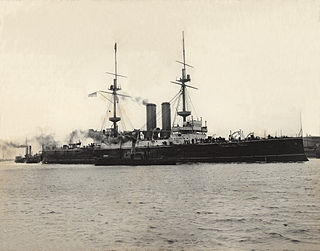
The Home Fleet was a fleet of the Royal Navy that operated from the United Kingdom's territorial waters from 1902 with intervals until 1967. In 1967, it was merged with the Mediterranean Fleet creating the new Western Fleet.

The Cruiser Squadron was a naval formation of the British Home Fleet consisting of Armored cruisers of the Royal Navy from 1899 to 1905.

The British Mediterranean Fleet, also known as the Mediterranean Station, was a formation of the Royal Navy. The Fleet was one of the most prestigious commands in the navy for the majority of its history, defending the vital sea link between the United Kingdom and the majority of the British Empire in the Eastern Hemisphere. The first Commander-in-Chief for the Mediterranean Fleet was the appointment of General at Sea Robert Blake in September 1654. The Fleet was in existence until 1967.

The Atlantic Fleet was a naval fleet of the Royal Navy. It existed for two periods; 1909 until 1914, and then 1919 until 1932.

The Channel Fleet and originally known as the Channel Squadron was the Royal Navy formation of warships that defended the waters of the English Channel from 1854 to 1909 and 1914 to 1915.

The First Cruiser Squadron was a Royal Navy squadron of cruisers that saw service as part of the Grand Fleet during World War I, then later as part of the Mediterranean during the Interwar period and World War II. It was first established in 1904 and existed until 1952.

The 2nd Light Cruiser Squadron was a naval formation of light cruisers of the Royal Navy from 1914 to 1925.

The British Adriatic Squadron, or simply the Adriatic Squadron and later known as the British Adriatic Force, was a military formation of the Mediterranean Fleet during World War I based at Taranto from 1915–19.

The 7th Battle Squadron was a squadron of the British Royal Navy assembled prior to World War I it was assigned to the Third Fleet and consisted of pre-dreadnought type battleships the oldest ships in fleet it existed from 1912 to 1914.

The 8th Battle Squadron was a squadron of the British Royal Navy assembled prior to the beginning of World War I; it was later assigned to the Third Fleet. The squadron consisted of pre-dreadnought type battleships. It existed from 1912 to 1914.
The 2nd Division was a naval formation of the British Home Fleet it was formed before First World War in March 1909 and was active until May 1912.

The 2nd Cruiser Squadron was a formation of cruisers of the British Royal Navy from 1904 to 1919 and from 1921 to 1941 and again from 1946 to 1952.

The 9th Cruiser Squadron was a formation of cruisers of the Royal Navy from 1912 to 1919 and again from 1939 to 1940. Cruiser squadrons consisted of five to six ships in wartime and in peacetime as low as two to three ships. From 1914 until 1924/25 they were designated as Light Cruiser Squadrons then after 1925 redesignated as Cruiser Squadrons.

The 10th Cruiser Squadron, also known as Cruiser Force B was a formation of cruisers of the British Royal Navy from 1913 to 1917 and then again from 1940 to 1946.

The 11th Cruiser Squadron and also known as Cruiser Force E was a formation of cruisers of the British Royal Navy from 1914 to 1917 and again from 1939 to 1940.

The 12th Cruiser Squadron also known as Cruiser Force G was a formation of cruisers of the British Royal Navy from 1914 to 1915 and then again from 1939 to 1943.
The 1st Destroyer Flotilla, also styled as the First Destroyer Flotilla, was a naval formation of the British Royal Navy from 1909 to 1940 and again from 1947 to 1951.
The British 3rd Destroyer Flotilla, also styled as Third Destroyer Flotilla, was a naval formation of the Royal Navy from 1909 to 1939 and again from 1945 to 1951.

The British 4th Destroyer Flotilla or Fourth Destroyer Flotilla, was a naval formation of the Royal Navy from August 1909 to July 1951.
The British 13th Destroyer Flotilla, or Thirteenth Destroyer Flotilla, was a naval formation of the Royal Navy from November 1915 – November 1918 and again from September 1939 to January 1944.







